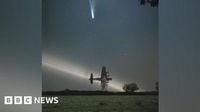For skywatchers and photographers alike, October and November 2025 have offered a rare celestial treat: the appearance of Comet Lemmon, officially known as C/2025 A6. Discovered in January by astronomers at the Mount Lemmon Survey in Arizona, this icy wanderer has made its closest approach to Earth in over a millennium, prompting enthusiasts across the UK to brave chilly nights and unpredictable weather for a glimpse—and a photograph—of its fleeting beauty.
Among those who succeeded in capturing the comet’s ethereal glow was Dominic Reardon, a 29-year-old photographer from Arnside, Cumbria. According to BBC News, Reardon traveled to Muker in North Yorkshire on October 25, 2025, after spending two weeks “watching the weather forecast like a hawk.” His patience paid off. “I’d been trying to find a gap in the weather for two weeks and had tried a couple of times before, but I would get fully set up—which takes a good 30-45 minutes—only to have the night ruined by clouds, rain or wind,” Reardon explained. “I had thought I wasn’t going to get chance to capture it, and then finally got an opportunity. I was excited and relieved.”
Reardon’s determination was matched by his technical preparation. To photograph Comet Lemmon, he used a telephoto lens paired with a star tracker—a device that allows the camera to follow the movement of celestial objects, compensating for Earth’s rotation and enabling longer exposures. Over a two-hour window from 17:00 to 19:00, he took multiple exposures, later blending them with a separate image of a stone house in the Yorkshire Dales to create a striking composite. The result: a luminous ball of light with a tail fading from white to blue, streaking above the solitary building and the dry stone walls lining the roadside.
Reardon wasn’t alone in his quest to immortalize Comet Lemmon. Steve Fearn, a 52-year-old photographer from Lincolnshire, also managed to snap the comet as it appeared over the Lancaster bomber sculpture in Norton Disney. The sculpture, titled “On Freedom’s Wings,” honors the RAF crews of World War Two and provided a dramatic foreground for Fearn’s image. As reported by BBC News, Fearn used a tracking mount—similar to Reardon’s star tracker—to counteract the Earth’s rotation and keep the comet sharp during a long exposure. He described the experience as “quite a buzz, capturing something so unique,” adding, “I feel very lucky to have captured it.”
Fearn’s photograph included not only the comet’s distinctive blue ion tail—a feature that made it especially satisfying to observe—but also a mysterious grey light streaking across the sky. He believes this was fuel from a SpaceX rocket, adding an unexpected modern twist to the scene. Fearn is no stranger to cosmic photography, having previously captured images of Comet Neowise and Comet Atlas, but even for him, Comet Lemmon was a standout. “Comet Lemmon is nice to look at because it has quite a distinctive blue ion tail, so it was quite satisfying,” he remarked.
So, what makes Comet Lemmon such a rare visitor? As explained by the Royal Astronomical Society, comets are vast balls of ice, dust, and rock that orbit the sun, developing long, luminous tails as they approach the solar heat. Comet Lemmon’s journey is especially noteworthy: it won’t return for another 1,300 years. Its closest approach to Earth occurred on October 21, 2025, when it passed within 56 million miles (90 million kilometers) of our planet—a safe distance, but close enough for amateur astronomers to train their lenses skyward.
The comet’s appearance has also coincided with the annual Orionid meteor shower, adding to the spectacle for those willing to brave the cold nights. The meteor shower, caused by debris from Halley’s Comet, is expected to remain visible until November 7, 2025, offering a double dose of astronomical excitement. According to the Royal Astronomical Society, Comet Lemmon will reach its closest point to the sun on Tuesday, November 4, 2025, before fading from view as it continues its long journey through the outer solar system.
For those unfamiliar with the technical side of astrophotography, capturing a comet is no small feat. Both Reardon and Fearn had to contend with the notoriously unpredictable British weather, setting up their equipment only to be thwarted by clouds, rain, or gusty winds. The use of star trackers and tracking mounts is essential, as these devices allow for longer exposures without the stars—or the comet itself—turning into blurry streaks. Even with the right gear, patience and luck play a huge role. As Reardon’s experience demonstrates, sometimes it takes multiple attempts and a dose of perseverance to get the shot.
The images produced by these photographers do more than simply document a scientific event—they connect the present with the past and future. Fearn’s choice to frame the comet above the Lancaster bomber sculpture, for instance, links the fleeting beauty of the cosmos with a monument to human courage and sacrifice. “On Freedom’s Wings” serves as a reminder of the RAF crews who flew dangerous missions during World War Two, while the comet above hints at the vastness and mystery of the universe that has inspired generations to look up and wonder.
Meanwhile, Reardon’s photograph, with its solitary house and rugged Yorkshire landscape, evokes a sense of quiet awe and the enduring human desire to capture and share moments of wonder. In an age when most of us are glued to screens, these images invite us to step outside, look skyward, and appreciate the grandeur of the universe—and the dedication of those who work to bring it into view.
Comet Lemmon’s brief visit has sparked excitement not only among seasoned astronomers but also among casual stargazers. With its distinctive blue tail and the knowledge that it won’t return for over a thousand years, it’s little wonder that so many have made the effort to see it. And while the comet will soon fade from the night sky, the photographs and memories it leaves behind will endure, serving as a testament to both cosmic wonder and human curiosity.
As the Orionid meteor shower continues and Comet Lemmon approaches the sun, the skies over the UK remain a stage for nature’s most captivating performances. For those lucky enough to witness or photograph the comet, it’s a once-in-a-lifetime experience—one that, like the comet itself, will not soon be forgotten.




